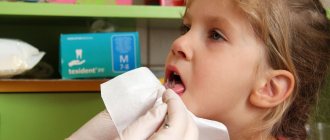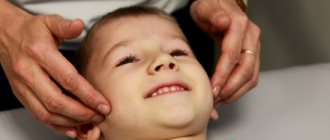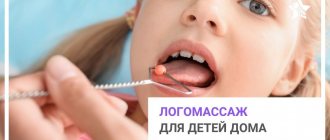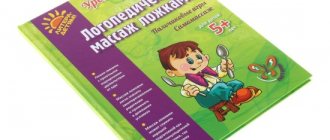Delayed speech development in a child at an early age is, alas, not uncommon, but a problem that requires a comprehensive solution, including a mandatory visit to the doctor. If the pathology is caused not by psychological constriction, but by physiological characteristics, tongue massage and articulation gymnastics are highly effective in treatment. We’ll figure out how to massage a child’s tongue, what indications and contraindications exist, and what are the features of the procedure. We remind you: before treatment, consultation with a doctor is required!
Benefits and effectiveness of baby tongue massage
Speech therapy massage is the most effective method for correcting speech defects and developmental delay problems. The acupressure complex is absolutely painless and does not cause discomfort in the child, allowing:
- reduce emotional stress;
- activate the muscles of the tongue;
- correct sounds that are difficult for children (L and R, G and D, hissing);
- get rid of stuttering and voice disorders;
- reduce saliva secretion;
- improve speech breathing performance;
- normalize muscle tone.
The difficulty when massaging the tongue is that not every baby is ready to stay in one position with an open mouth for a long time - restless children tolerate manipulation more difficult, so psychological preparation on the part of parents is especially important.
II. Types of massage
The field of speech therapy is so developed today that listing all the techniques would require writing a huge book. We will talk about the main techniques that are most often used in logotherapy.
Five main types of logomassage:
- classical;
- spot
- hardware;
- self-massage;
- probe
The classic to the usual manual facial massage - stroking, rubbing, kneading, etc.
To perform acupressure, you need to know the “active” points of the body, that is, this procedure requires special knowledge.
You can massage your body using a medical device - this will be a hardware massage .
Self-massage is performed by a child - for this he needs to be taught how to bite his tongue and massage his face correctly.
The probe allows you to reach remote parts of the articulation organs and thereby activate their work.
Massage can be aimed at relaxing or activating the speech organs. If you want to relax your muscles, try to press lightly, use sliding movements. If you decide to activate the muscles and add tone to them, massage deeply and energetically.
For various types of logomassage, spoons, toothbrushes, spatulas and probes are used.
Indications for speech therapy massage in children
Speech therapy massage for a child is indicated for a range of disorders, the key of which are speech problems (incorrect pronunciation of sounds, stuttering, insufficient development in accordance with age). The procedure is especially effective for a number of articulatory and even psychological disorders:
- stuttering, regardless of the cause and severity;
- partial loss of voice or minor defects;
- cerebral palsy, developmental delay;
- speech pathologies – bradyllia, aphasia, dyslalia;
- low or, on the contrary, increased tone of the facial muscles;
- dysarthria, in which the tongue is limited in mobility.
Tongue massage is prescribed by a doctor - if a parent wants to use this therapeutic method, you first need to consult with a specialist to eliminate contraindications and understand that the procedure will be beneficial.
Contraindications for carrying out
Speech therapy tongue massage helps to cope with the following tasks:
- Correcting correct sound pronunciation.
- Normalization and formation of breathing (diaphragmatic, not upper or clavicular).
- Improving the condition and quality of the voice and vocal cords.
- Strengthening pharyngeal reflexes.
- Normalization of the correct trajectory of movement of the organs of articulation.
Parents should be aware that there are a number of contraindications. They are temporary and require you to postpone the activity for a while. For example, pediatric speech therapy massage is not recommended under the following circumstances:
- elevated temperature;
- colds or acute respiratory disease;
- inflammation of the gums;
- stomatitis;
- conjunctivitis;
- lymphatic drainage disorders;
- enlarged lymph nodes;
- if there is blood in the stool;
- herpetic infection.
There are other contraindications, which our specialist will inform you about in detail before starting the course. The video below clearly shows how speech therapy massage is done with probes:
How to massage a child’s tongue – procedure technique
There are several manipulation techniques, including massaging the tongue with a toothbrush - this procedure can be easily done at home. In speech therapy, special instruments, improvised means (brush or spoon), and fingers (only with gloves) are used to influence the tongue. If you plan to perform the massage yourself, follow the instructions:
- Warm up the work area by lightly stroking the skin of the face and neck - preparation will have a positive moral effect on the patient.
- Work the longitudinal muscle - you need to move from the root of the tongue to its tip.
- Walk along the transverse muscle, moving from the center to the lateral edges - being careful at the root of the tongue (causes a gag reflex).
- Perform light strokes in the oral cavity - the direction does not matter.
- Pat the surface of the tongue and again go over the longitudinal muscle.
- Treat the frenulum of the tongue with rubbing movements (you can use a gauze napkin).
The result is noticeable only with regularity - the cycle consists of 10-20 sessions (depending on the clinical picture and the achieved effect). To consolidate the therapeutic effect, take a break for 1-2 months and repeat the course.
How to do speech therapy massage yourself
Below are a few options that you can do at home yourself. The only thing I recommend is to go to a good speech therapist so that he can see if you are doing everything correctly. At the same time, the specialist will give recommendations for your case.
Before doing speech therapy massage at home, you need to ventilate the room well. Another important point is the absence of any painful sensations - all manipulations should be painless.
Method of speech therapy massage according to E.Ya. Sizova
All manipulations are performed with clean, warm hands, at least twice a day (morning and evening). We take no more than 5-7 exercises. We begin and end the massage with stroking.
Lip exercises:
- We stroke the upper lip from the middle to the corners of the mouth, without going back (5-7 times). Movements are performed slowly, without pressure.
- We do the same with the lower lip;
- We close our lips and stroke them from the middle to the corners of the mouth (5-7 times).
- We lightly tap the lips from the middle to the corners of the mouth with both hands (3-4 times).
- We perform spiral movements along the lips from the middle to the corners of the mouth (3-4 times). They can be done on each lip separately or on closed lips. We do not touch the nasolabial triangle.
- “Duckling” - lips are closed and slightly extended. Lightly pinching the lips (5–7 times) is performed.
- “Acupressure in the corners of the lips” - fingers are placed on the corners of the lips and circular movements are made in one place (5-7 times).
- We close our lips and stroke them from the middle to the corners of the mouth (5-7 times).
For the lower jaw:
- Stroking with two fingers from the middle of the lower jaw to the cheekbones (5-7 times).
- Lightly tap with two fingers from the middle of the lower jaw to the cheekbones (5-7 times).
- Spiral movements with two fingers from the middle of the lower jaw to the cheekbones (5-7 times).
- Lightly pinching with your fingers from the middle of the lower jaw to the cheekbones (5-7 times).
- Stroking with two fingers from the middle of the lower jaw to the cheekbones (5-7 times).
For language:
- Stroking the protruding tongue and its lateral edges from center to middle (5–7 times).
- Patting the protruding tongue from the middle downwards with the second and third fingers horizontally (5–7 times).
- Tapping the protruding tongue and its lateral edges from center to middle (5–7 times).
- Spiral movements along the protruding tongue from the middle to the tip of the tongue (5-7 times).
- Pinching with light movements of the tip of the tongue (5-7 times).
- Stroking the protruding tongue and its lateral edges from center to middle (5–7 times).
For the palate:
- Stroking the palate from the teeth into the depths of the oral cavity to the soft palate (5–7 times).
- Lightly tap the palate from the teeth into the depths of the oral cavity to the soft palate (5–7 times).
- Zigzag movements (right-left) along the center line of the palate (5-7 times).
- Spiral movements along the central line of the palate (5–7 times).
- Stroking the palate from the teeth into the depths of the oral cavity to the soft palate (5–7 times).
Massage with a toothbrush
It requires little preparation. First of all, you need to buy the toothbrush itself. It should be clean and specifically designed for activities, not for brushing teeth. The bristle of the brush should be soft. Additionally, you will need to buy a bandage. Before class you will need to make several swabs. They are placed under the tongue to collect saliva, which will be actively released during the massage. It is important to change tampons with new ones on time. This will need to be done approximately every 2 minutes.
If the mother of a small child acts as a massage therapist, in order to relax the baby, you need to carry out all the exercises in active contact and communication. You can hum a song, tell a fairy tale, turn on classical music, put out your favorite toys. You need to adapt to your child.
All massage exercises are based on stroking and light vibration. With the help of the latter, it is possible to achieve relaxation of muscles that are in hypertonicity. Stroking is performed with spiral or circular movements. The pressure should not be strong.
In the case when speech therapy massage is performed on a child with cerebral palsy, you need to choose the right position. It could be like this:
- Lying on your back. Be sure to put a cushion under your head. The lower limbs should be bent at the knees.
- Embryo position.
- On the stomach. A cushion is placed in the chest area.
When performing massage for cerebral palsy, the massage technique is aimed at relaxing the muscles of the tongue. Additionally, the zygomatic muscles, nasolabial fold and submandibular muscles are affected.
Massage with spoons
An important condition for any massage is the cleanliness of the hands and instruments that the specialist will use during the procedure. Speech therapy massage with spoons is performed using ordinary cutlery. The only condition: the absence of patterns and other protruding elements on the spoon that can injure the mucous membrane.
To perform the massage, you will need to take 2 teaspoons and a few in reserve in case they fall on the floor.
Parents should understand that if there are problems with speech, the tongue needs massage to a greater extent, but without activating the entire speech apparatus it is impossible to achieve the desired result. All exercises are repeated 8 times. The technique for performing speech therapy massage with spoons is as follows:
- Stroking the child's temples with the convex side of a spoon. Movements should be directed clockwise.
- Lightly stroking the eye sockets with the rounded side of the spoon. The spoon is initially guided along the brow ridge towards the outer corner of the eye. The spoon is returned under the eye.
- The convex side of the cutlery is used to stroke the child’s cheeks.
- Spiral movements with the convex side of the device in the temple area. Finally, you can do a few light presses (you need to be very careful).
- The chewing and mental muscles are kneaded in a circular motion with the rounded side of the spoon.
- Use the tip of the cutlery to “scrape” along the upper and then the lower lip. After this, make frequent presses.
When performing a massage, most children experience excessive salivation, so work is necessary to overcome drooling:
- Teach children to chew and swallow well first by example. You can first perform a passive movement, take the child by the chin and, as it were, make chewing movements up and down several times a day. You can use a pacifier to teach the swallowing process. First, we put it in the baby’s mouth, then we press on it so that the liquid flows out, we pull it out and make massaging movements in the neck area until the child swallows. Try to give your baby less pureed food, and more often boiled and dried meat.
- Teach how to suck up saliva and often swallow saliva in one push before doing exercises.
It is important to end the massage session correctly. To do this, you need to stroke your face with your hands and praise the child. A favorite game or a small surprise in the form of a sticker is considered a good conclusion to the procedure. The baby will be guaranteed a positive attitude, and next time he will agree to the procedure without any problems, knowing that a reward will follow.
In the presence of deep pathologies (rhinolalia, cerebral palsy) affecting the speech apparatus, it is not recommended to attempt to correct the defect on your own. Each child, as well as his clinical picture, is individual and requires a special approach for speech development, correction and treatment of disorders.
Contraindications – when is tongue massage harmful to a child?
The absence of contraindications is determined by a neurologist - the doctor documents the safety of the massage for the child (manipulations at home, in a government institution, or with a private specialist are prohibited without a certificate). You cannot massage your tongue if:
- there are injuries, wounds, cuts in the oral cavity;
- diagnosed with stomatitis, gingivitis, common infectious diseases;
- the child has enlarged lymph nodes;
- the child is afraid of the procedure - often the fear is caused by the unknown and the frightening appearance of the instruments;
- there are blood supply disorders, fungal infections, cancer;
- hypersensitive skin.
Doing a tongue massage on a child with your own hands is not easy; it is better to entrust this task to a professional massage therapist - ideally a child massage therapist, since such a specialist knows how to work with children, easily finds an approach to them, and carries out procedures without hysterics or discomfort for children. Moreover, without the proper experience and skills, a parent can injure the child, cause him pain and fail to achieve the goal - the manipulations will be useless, and invaluable time will be lost.
The use of innovative equipment in speech therapy work with children
Cherchenko Zoya Mikhailovna
The use of innovative equipment in speech therapy work with children
Specific features of impaired sound pronunciation in dysarthria are the persistence of defects and the difficulty of overcoming them, as well as the need for a longer period of automation of sounds. Children with dysarthria often suffer from attention deficit and hyperactivity, they are difficult to captivate with anything, they get tired quickly, etc.
As a rule, parents do not carry out drug treatment prescribed by neurologists or physiotherapeutic procedures.
In this regard, the correction process has a long and complex dynamics.
There is a need for more active medical and pedagogical influence using “bypass”
auxiliary means to achieve an effect in eliminating dysarthric manifestations.
To interest children and make learning meaningful, we need non-standard approaches, individual development programs, and new innovative technologies . Against the backdrop of comprehensive speech therapy assistance, innovative technologies , without requiring much effort, optimize the process of correcting children’s speech and contribute to the healing of the entire body.
I would like to present to your attention a new speech therapy instrument, the speech therapy electric massager Z-Vibe, which is an innovation that integrates general speech therapy massage and high-frequency electromagnetic vibrations.
The device consists of an aluminum case, which contains a micromotor-vibrator, a battery, and a replaceable threaded tip.
The tips change depending on the need for impact (relaxation - stimulation)
.
Additional tips are sold separately.
A speech therapy massager has a diameter no larger than a ballpoint pen. Replaceable vibrating massager attachments are made of food-grade plastic, do not contain harmful dyes and can withstand sterilization with UV lamps.
Made in USA
The principle of operation of Z-Vibe is to influence the tongue, inner and outer surfaces of the cheeks, forehead, chin with high-frequency vibrations. As a result of these vibrations, muscle tone relaxes or increases, depending on the attachments used . The transfer of small, fast, alternating oscillatory movements to the tissues causes strong contraction of the muscles and gives them greater elasticity, improves tissue trophism. The purpose of the massage is to normalize speech motor skills.
The method of speech therapy involves performing basic standard massage movements. The main universal attachment of the massager has two different surfaces: lumpy and striated. Used for cheeks , lips, tongue, gums, palate.
The cross-striped side is aimed at normalizing the muscles of the art. device for hypertonicity;
The lumpy side is aimed at normalizing the muscles of the art. device for hypotension.
Attachment for speech therapy massager Z-Vibe for massaging the hollow of the tongue
This attachment is designed for speech therapy vibration massager; it allows you to quickly create and prepare a “groove” in the child’s tongue for subsequent production of sounds.
It is also used for speech therapy massage , in places where the accuracy of the speech therapist’s .
Ribbed attachment for speech therapy massager Z-Vibe .
This attachment is used both for external speech therapy massage of lips , cheeks, etc., and for massage of the child’s articulation apparatus.
In addition, the massager helps to very effectively stretch the frenulum, support the tongue, and massage the hollow of the tongue to help produce whistling sounds. Also, it is very effective in producing vibration of the tip of the tongue when making the sound “R”
.
For this purpose, “artificial starting of the motor”
is used Experience with dysarthria confirms that the use of the Z-Vibe electric massager optimizes work the organic manifestations of dysarthria. In addition, as studies indicate, the massager has proven itself very well in working with children with hearing impairments .
Device for monitoring your own speech
This device is used during classes with a speech therapist to develop phonemic hearing and independent control of speech in a child.
During classes with a speech therapist , the child holds the device like a telephone handset and pronounces phrases.
The whole effect is that the child hears himself without distortion through the “inner hearing of a person” and is able to correct speech depending on what he hears.
The device uses only mechanical principles of sound transmission.
Specialized computer technology for correcting general speech underdevelopment “Games for Tigers”
Designed to correct general speech underdevelopment in children of older preschool age.
Program "Games for Tigers"
offers more than 50 exercises with several levels of difficulty, combined into four thematic blocks:
— "Prosody"
,
— "Sound Pronunciation"
,
— "Phonematics"
,
— "Vocabulary"
.
Work with all exercises in the program is carried out based on visual control over the results of the child’s activities. They are visualized on the monitor screen in the form of cartoon images and symbols. In some exercises that cause difficulties, the possibility of additional auditory support is provided when performing the task.
On the computer side, it is not an impersonal program, but a cheerful and amusing computer hero, Tiger Cub, who explains to the child the purpose and rules for completing the proposed task, helps to complete it, and gives a final or intermediate assessment of the action performed.
Program "Games for Tigers"
easy to operate. It has an accessible interface with tooltips.
Block "Prosodika"
.
operating principle of this unit is based on interactive communication between a child and a computer using a microphone . In this case, speech activity is recorded by a microphone and presented on the computer screen in the form of visual animations.
Selection of exercises included in the “Prosody”
, is made from a submenu that includes four modules.
Module "Breathing"
.
The exercises in this module allow you to practice smooth, long or short, sharp exhalation, track the moment speech activity starts, and also measure the strength and duration of speech exhalation and voice (in relative units and in seconds, respectively)
.
Module "Confluence"
.
The exercises in this module allow you to work on the clarity and intelligibility of a child’s speech based on phrases, the strength and duration of exhalation and voice based on speech exhalation without phonation, with phonation - based on vowels and consonants, and practice the continuous pronunciation of sounds, syllables , words and phrases.
Module "Rhythm"
.
Exercises of the module "Rhythm"
allow you
to work on the rhythmic and syllabic structure of the word , as well as on the clarity and intelligibility of the child’s speech.
Module “Pitch and Timbre”
.
In this module, the computer speech therapy program “Games for Tigers”
allows you to visually record and measure the frequency characteristics of speech for the purpose of further correction in the exercises of this module, as well as select an acceptable timbre range of speech in a child with phonation disorders.
The exercises in this module also allow you to build vocal tasks for the development of the child’s vocal apparatus. This is facilitated by working on speech exhalation , height and duration of the voice.
Work on the exercises of this module is based on individual sounds, their complexes, syllables , words, phrases.
Block “Sound Pronunciation”
.
Working with exercises in the “Sound Pronunciation”
allows you to develop the efferent
(development of motor properties of the organs of articulation)
and afferent motor part of the speech system.
Block "Phonematics"
.
Sounds module
.
Exercises from the Sounds
allow you
to work on the development of phonemic hearing using the material of non-speech sounds, speech sounds and sound complexes.
Module "Words"
.
Exercises of the module "Words"
can
be used for the development of phonemic hearing based on words, correction of sound pronunciation at the stage of automation and differentiation of defective sounds, as well as for the development of the child’s vocabulary and thinking.
"Analysis" module
.
Exercises in the Analysis
allow you to organize
work on the formation of phonemic perception in children, correction of sound pronunciation at the stage of automation of defective sounds.
Module "Synthesis"
.
Exercises of the module "Synthesis"
allow you
to work on the formation of phonemic synthesis in children.
Block "Vocabulary"
.
This block is aimed at correcting lexico-grammatical speech disorders in children. The block includes three modules. Exercises within each module allow you to organize correctional work in a specific direction.
When working with the exercises of this block, children’s vocabulary is formed on the main topics: “Clothing”
,
“Shoes”
,
“Furniture”
,
“Utensils”
,
“Tools”,
etc., the concept and meaning of generalizing words is formed.








